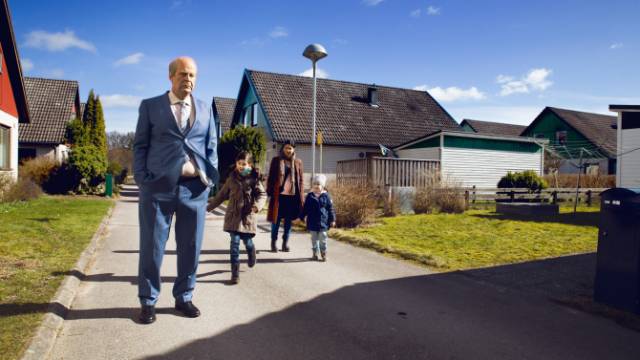
 A Man Called Ove is a Norwegian film based on a Norwegian book whose English translation is doing brisk business in the US. It is about a cranky old man who is “given a new lease on life” upon meeting his spirited new neighbors. It has the sort of synopsis that comes with an implicit promise: like movies about dogs or old couples who die in each other’s arms, this movie will make you cry. To some degree, all of its elements are neatly in accordance with its formula: a grouch whose heart of gold is gradually revealed, uncomplicated treatments of timely social issues, and scrappiness ultimately defeating the powers that be. But it has a couple elements that stray outside of its formula that make it an interesting document of what is capturing the public imagination today.
A Man Called Ove is a Norwegian film based on a Norwegian book whose English translation is doing brisk business in the US. It is about a cranky old man who is “given a new lease on life” upon meeting his spirited new neighbors. It has the sort of synopsis that comes with an implicit promise: like movies about dogs or old couples who die in each other’s arms, this movie will make you cry. To some degree, all of its elements are neatly in accordance with its formula: a grouch whose heart of gold is gradually revealed, uncomplicated treatments of timely social issues, and scrappiness ultimately defeating the powers that be. But it has a couple elements that stray outside of its formula that make it an interesting document of what is capturing the public imagination today.
The title character, Ove (Rolf Lassgård), has worked his whole life on a trainyard until an early scene in which he is summarily laid off by some clueless, young suits. Here we see the basic themes of the movie: a distrust of administrative overreach with locomotives as a constant presence.
Cars, trains, and buses are one of the main characters of the movie. Ove is obsessed with Saabs; he first engages with his new neighbors when they can’t properly back their U-Haul in; he gives the mother of said family of neighbors (Bahar Pars) driving lessons; etc. A train is a vehicle for the most fortuitous meeting in his life, and literally a symbol for the ascension into the afterlife. But it also causes one of the most startling and painful moments of the movie. And that’s just one of several locomotive-related tragedies.
Meanwhile, men in “white shirts” punctuate every episode of Ove’s considerable history which is told in flashbacks. In his youth, they have it out for his home because it doesn’t adhere to building regulations. In the present, they threaten to institutionalize Ove’s estranged old friend, Rune (Börje Lundberg), who is incapacitated by a stroke. Ove is a man who knows how to take care of himself and his own, but his competence is only ever foiled or maliciously attacked by these agents of evil.
It’s an interesting subtext for a story from Norway, one of the few countries with an explicit, modern form of socialism. Intervening administrative agents are certainly not looked on kindly here. But if Ove is the cantankerous and capable relic who represents opposition to an age of nannying, a simple reading of old=good, new=bad is complicated by the ambivalent symbolic status of the locomotive. The train, car, and bus — archetypical symbol of the modern world rushing forward — are neither good nor bad. They are everything.
It is a story obsessed with the torture and euphoria of the modern world, but unable to stop looking backward for safety. But, um, also about grumpy old Ove taking in a stray cat and a gay runaway, and learning to laugh again with his middle Eastern neighbor. Really, it’s a lot of bang for your buck.